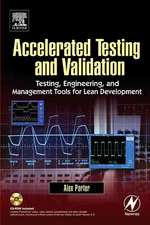Point Process Models with Applications to Safety and Reliability
Autor W. Thompsonen Limba Engleză Paperback – 8 oct 2011
Preț: 380.07 lei
Nou
Puncte Express: 570
Preț estimativ în valută:
72.73€ • 76.03$ • 61.46£
72.73€ • 76.03$ • 61.46£
Carte tipărită la comandă
Livrare economică 06-20 martie
Preluare comenzi: 021 569.72.76
Specificații
ISBN-13: 9781461284062
ISBN-10: 1461284066
Pagini: 164
Ilustrații: XII, 146 p.
Dimensiuni: 152 x 229 x 9 mm
Greutate: 0.23 kg
Ediția:Softcover reprint of the original 1st ed. 1988
Editura: Springer Us
Colecția Springer
Locul publicării:New York, NY, United States
ISBN-10: 1461284066
Pagini: 164
Ilustrații: XII, 146 p.
Dimensiuni: 152 x 229 x 9 mm
Greutate: 0.23 kg
Ediția:Softcover reprint of the original 1st ed. 1988
Editura: Springer Us
Colecția Springer
Locul publicării:New York, NY, United States
Public țintă
ResearchCuprins
1 Introduction.- 1.1 Arrivals in time.- 1.2 Reliability.- 1.3 Safety assessment.- 1.4 Random stress and strength.- Notes on the literature.- Problems.- 2 Point processes.- 2.1 The probabilistic context.- 2.2 Two methods of representation.- 2.3 Parameters of point processes.- 2.4 Transformation to a process with constant arrival rate.- 2.5 Time between arrivals.- Notes on the literature.- Problems.- 3 Homogeneous Poisson processes.- 3.1 Definition.- 3.2 Characterization.- 3.3 Time between arrivals for the hP process.- 3.4 Relations to the uniform distribution.- 3.5 A process with simultaneous arrivals.- Notes on the literature.- Problems.- 4 Application of point processes to a theory of safety assessment.- 4.1 The Reactor Safety Study.- 4.2 The annual probability of a reactor accident.- 4.3 A stochastic consequence model.- 4.4 A concept of rare events.- 4.5 Common mode failures.- 4.6 Conclusion.- Notes on the literature.- Problems.- 5 Renewal processes.- 5.1 Probabilistic theory.- 5.2 The renewal process cannot model equipment wearout.- Notes on the literature.- Problems.- 6 Poisson processes.- 6.1 The Poisson model.- 6.2 Characterization of regular Poisson processes.- 6.3 Time between arrivals for Poisson processes.- 6.4 Further observations on software error detection.- Notes on the literature.- Problems.- 7 Superimposed processes.- Notes on the literature.- Problems.- 8 Markov point processes.- 8.1 Theory.- 8.2 The Poisson process.- 8.3 Facilitation and hindrance.- Notes on the literature.- Problems.- 9 Applications of Markov point processes.- 9.1 Egg-laying dispersal of the bean weevil.- 9.2 Application of facilitation — hindrance to the spatial distribution of benthic invertebrates.- 9.3 The Luria-Delbrück model.- 9.4 Chance placement of balls in cells.- 9.5 Amodel for multiple vehicle automobile accidents.- 9.6 Engels’ model.- Notes on the literature.- Problems.- 10 The order statistics process.- 10.1 The sampling of lifetimes.- 10.2 Derivation from the Poisson process.- 10.3 A Poisson model of equipment wearout.- Notes on the literature.- Problems.- 11 Competing risk theory.- 11.1 Markov chain model.- 11.2 Classical competing risks.- 11.3 Competing risk presentation of reactor safety studies.- 11.4 Delayed fatalities.- 11.5 Proportional hazard rates.- Notes on the literature.- Problems.- Further reading.- Appendix 1 Probability background.- A1.1 Probability distributions.- A1.2 Expectation.- A1.3 Transformation of variables.- A1.4 The distribution of order statistics.- A1.5 Conditional probability.- A1.6 Operational methods in probability.- A1.7 Convergence concepts and results in the theory of probability.- Notes on the literature.- Appendix 2 Technical topics.- A2.1 Existence of point process parameters.- A2.2 No simultaneous arrivals.- Solutions to a few of the problems.- References.- Author index.








